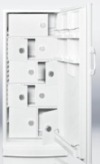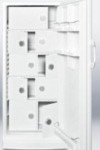
Forensic Refrigerator has Lockable Compartments

Health practitioners, law enforcement agencies, defense and prosecuting attorneys know the value of properly handled and preserved forensic evidence to identify victims and suspects and to help build cases leading to verdicts by jurors. Procedures for the proper storage of these samples have been established, and proper refrigeration is a key element in many of these procedures.
Evidence such as blood and tissue samples that require refrigeration can be safely stored in a forensic laboratory refrigerator now available from Tovatech. It has 6 compartments 8-1/4”h x 9”w x 13”d, 2 at 11”h x 9”w x 7”d and one at 8-14”h x 9”w x 13”d. Each compartment has its own combination lock to help protect against unauthorized access. Totaling 10 cubic feet of storage space the 56-inch high forensic evidence refrigerator has a 2-foot square footprint and additional storage shelves in the reversible door.
Its compact size makes the TFFAR auto-defrost evidence refrigerator an excellent choice for storage at police departments and EMS facilities in small towns and rural areas. Metropolitan precincts and EMS substations can use the forensic refrigerator for temporary storage until evidence is moved to a central location.
Although each compartment of the TFFAR auto-defrost evidence refrigerator is safely enclosed the unit’s wire shelving allows the interior fan to circulate refrigerated air evenly from top to bottom. This provides uniform refrigeration protection to all evidence containers. The refrigeration temperature is set from 36˚ to 46˚F using a dial-type thermostat.
Crime scene investigators protect the contents of storage compartments by setting their own combination codes. In an emergency or in the event of lost combinations forensic department supervisors can access the compartments by using a master key.
Contact the scientists at Tovatech for expert information on selecting scientific and laboratory refrigerators and freezers tailored to your particular requirements and budgets.
How is perishable forensic evidence stored at your facility? What security measures are in place to avoid evidence tampering?
